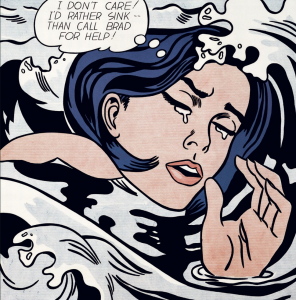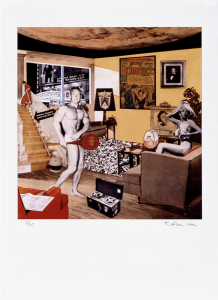Postmodernism within art refers specifically to ‘a reaction against modernism which has dominated art theory and practise since the beginning of the twentieth century.’ [1] Guerrilla Girls is an anonymous group of radical feminist, female artists devoted to fighting sexism and racism within the art world.’ [2] The idea to be anonymous is bold and allows the issue to be the focus rather than the artist. The group formed in 1985 and are still producing work now, throughout all those years their work is distinctive. The use of bold san serif fonts being a prominent part of their design is easily recognisable. Furthermore, the classic and iconic monkey masks and banana images used within their projects. A piece of work they have created that I find very intriguing is ‘Dear art collectors – boys will be boys.’ The design is overly ‘girly’ the pink backdrop background against the calligraphy typeface juxtaposes with their other work which is brash and audacious. This piece is bold in its own way. It’s funny and patronising as such which contrasts with how women are viewed. Its a critical piece of work especially considering the era it was created – 1985. I have a keen interest in graphic design and its important for me to considering designing work regarding an issue. Therefore, this piece of postmodernism is great inspiration.
Roy Lichtenstein was a pop artist who’s work defined the premise of pop art through parody. Although Lichtenstein work mocks pop art his work in undoubtedly iconic and work you can be inspired by. He re-appropriates work from comic books to recreate a whole new piece of art. Drowning girl is an example of this. This piece uses the conventions of comic book art, thought bubble and ben-day dots. He deconstructs the original artwork to create something new. Similar to graphic design, you’re continuously inspired by movements and artists. Influenced by past work enables artists to create something new.
Richard Hamilton’s ‘Just what was it that made yesterday’s homes so different, so appealing?’ Is among the most famous in British post war art. Hamilton began this collage by planning categories he would incorporate into the work. So he typed out a list: ’Man, Woman, Food, History, Newspapers, Cinema, Domestic Appliances, Cars, Space, Comics, TV, Telephone, Information’ (quoted in Richard Hamilton, 1992, p.149) The finished collage presents all the multiple ways of communicating information available at the time, reflecting Hamilton’s ironic interest in popular culture and modern technology. [3] Through this piece of work Hamilton is mocking materialist fantasies fuelled by modern advertisement. Photomontage is a interesting style and something I could consider myself when creating work. I could apply this same concept of collecting materials from other mediums and combining them with computer software to create a unique mixed medium outcome, combining the old with the new.
2-Tate. (n.d). Guerrilla Girls | Tate. [online] Available at: http://www.tate.org.uk/artists/guerrilla-girls-6858 [Accessed Nov. 2017]



